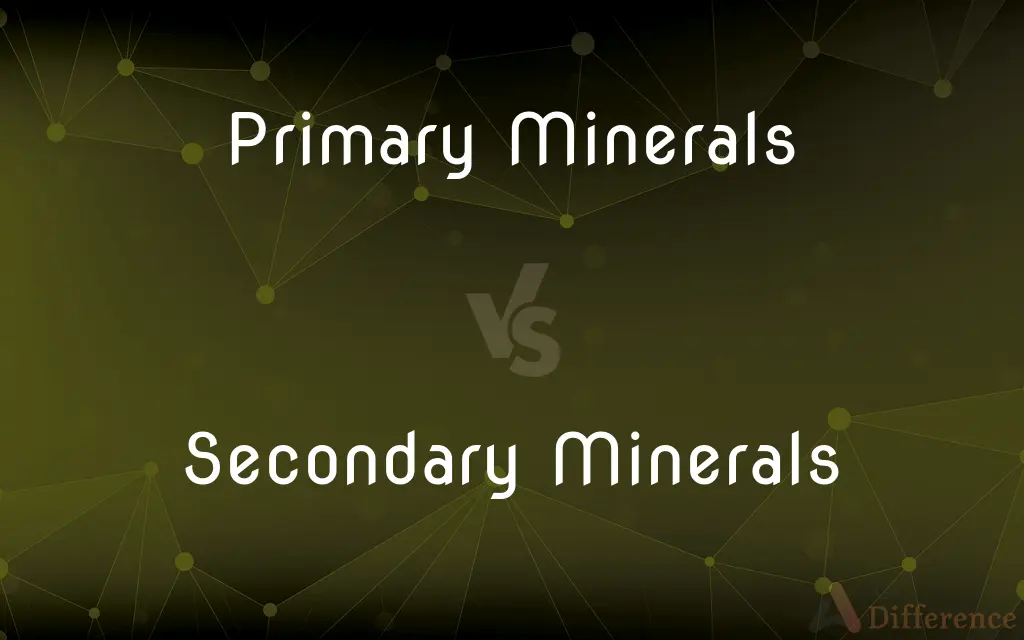Primary Minerals vs. Secondary Minerals — What's the Difference?
By Tayyaba Rehman — Published on November 19, 2023
Primary minerals originate directly from cooling magma, while secondary minerals form due to alteration or weathering of primary minerals.

Difference Between Primary Minerals and Secondary Minerals
Table of Contents
ADVERTISEMENT
Key Differences
Primary minerals are those that form during the solidification of the molten rock or magma. On the other hand, secondary minerals develop as a result of the alteration of primary minerals, typically due to environmental factors.
The chemical composition of primary minerals remains consistent with the original magma. Secondary minerals, conversely, possess a different composition, influenced by processes like weathering or hydrothermal activity.
In the field of geology, primary minerals are key to understanding the original composition and environment of rock formation. Secondary minerals offer insights into the subsequent changes and conditions the rock underwent.
Rocks that are rich in primary minerals often indicate a relatively undisturbed geological history. Those dominated by secondary minerals highlight regions that have faced significant weathering, alteration, or other geological transformations.
While primary minerals provide foundational components to many rock types, secondary minerals can dominate certain rocks, like clay, which is primarily made up of secondary minerals resulting from the decomposition of other rock types.
ADVERTISEMENT
Comparison Chart
Formation
Form during solidification of magma.
Develop from alteration of primary minerals.
Composition
Consistent with the original magma.
Altered due to environmental processes.
Geological Indicator
Indicate original rock composition and environment.
Highlight weathering, alteration, or transformations.
Presence in Rocks
Foundational components in many rock types.
Dominate in rocks like clay.
Influencing Factors
Temperature, pressure, and magma composition.
Weathering, hydrothermal activity, and environmental conditions.
Compare with Definitions
Primary Minerals
Remain unchanged since the rock's formation.
The olivine in peridotite is a primary mineral that hasn't been altered.
Secondary Minerals
Result from the alteration of primary minerals.
Clay minerals form as secondary minerals from the weathering of feldspar.
Primary Minerals
Unaltered constituents of igneous rocks.
The presence of quartz in a rock sample indicates primary minerals.
Secondary Minerals
Not originally part of the rock's formation but added later due to external influences.
The goethite in laterite soils is a secondary mineral formed from the weathering of primary minerals.
Primary Minerals
Direct products of crystallization from molten material.
Mica crystals in igneous rocks are often primary minerals.
Secondary Minerals
Products of weathering, hydrothermal activity, or other geological processes.
The formation of serpentine from olivine is a result of hydrothermal activity, making serpentine a secondary mineral.
Primary Minerals
Formed directly from solidifying magma.
Feldspar, found in granite, is a common primary mineral.
Secondary Minerals
Indicators of environmental changes or rock transformations.
The abundance of secondary minerals in soil shows significant weathering.
Primary Minerals
Indicators of the original rock environment and composition.
The primary minerals in basalt reveal its volcanic origin.
Secondary Minerals
Dominate in rocks formed by decomposition or alteration.
Shale often contains a high proportion of secondary minerals.
Common Curiosities
Why are secondary minerals important in geology?
They provide insights into the weathering, alteration, or transformations that a rock has undergone.
How do secondary minerals differ from primary minerals?
Secondary minerals result from the alteration or weathering of primary minerals.
What are primary minerals?
Primary minerals are those that form directly from the solidification of magma.
Can a rock have both primary and secondary minerals?
Yes, many rocks contain a mixture of both primary and secondary minerals.
What processes can lead to the formation of secondary minerals?
Processes like weathering, hydrothermal activity, and other environmental conditions can lead to the formation of secondary minerals.
What influences the formation of primary minerals?
Factors like temperature, pressure, and the composition of magma influence the formation of primary minerals.
Are primary minerals found in sedimentary rocks?
While sedimentary rocks can contain primary minerals, they are often dominated by secondary minerals.
Can primary minerals transform into secondary minerals?
Yes, primary minerals can alter or weather, leading to the formation of secondary minerals.
Are secondary minerals always formed from primary minerals?
Most commonly, secondary minerals form from the alteration of primary minerals, but they can also form from other secondary minerals.
Which is more common in clay, primary or secondary minerals?
Clay is primarily composed of secondary minerals.
Are secondary minerals stable?
Secondary minerals are generally more stable in the surface environment than primary minerals, as they have already undergone alteration.
What's an example of a primary mineral in granite?
Feldspar in granite is a typical primary mineral.
Can the presence of secondary minerals tell us about a rock's history?
Yes, secondary minerals can reveal significant information about the changes and conditions a rock has faced.
Which type of mineral is an indicator of a rock's original environment?
Primary minerals indicate a rock's original environment and composition.
Which mineral can transform from a primary to a secondary mineral due to weathering?
Feldspar, a primary mineral, can weather to form clay minerals, which are secondary.
Share Your Discovery

Previous Comparison
Catholic Bible vs. King James Bible
Next Comparison
Chemical Kinetics vs. ThermodynamicsAuthor Spotlight
Written by
Tayyaba RehmanTayyaba Rehman is a distinguished writer, currently serving as a primary contributor to askdifference.com. As a researcher in semantics and etymology, Tayyaba's passion for the complexity of languages and their distinctions has found a perfect home on the platform. Tayyaba delves into the intricacies of language, distinguishing between commonly confused words and phrases, thereby providing clarity for readers worldwide.
















































